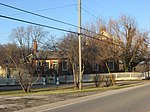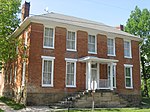Randolph Mitchell House
Federal architecture in OhioHouses completed in 1828Houses in Perry County, OhioNational Register of Historic Places in Perry County, OhioNeoclassical architecture in Ohio

The Randolph Mitchell House is a historic house in the small community of New Reading, Ohio, United States. One of the most prominent old buildings in the area's oldest settlement, it was once the home of a leading local resident, and it has been named a historic site because of its distinctive Neoclassical-influenced architecture.
Excerpt from the Wikipedia article Randolph Mitchell House (License: CC BY-SA 3.0, Authors, Images).Randolph Mitchell House
Rush Creek Road,
Geographical coordinates (GPS) Address Nearby Places Show on map
Geographical coordinates (GPS)
| Latitude | Longitude |
|---|---|
| N 39.81 ° | E -82.353333333333 ° |
Address
Rush Creek Road 5788
43783
Ohio, United States
Open on Google Maps







